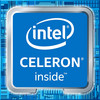Rockchip RK3288 vs Intel Celeron J4105 vs Google Tensor G4
Rockchip RK3288
► remove from comparison
Der Rockchip RK3288 ist ein Mittelklasse ARM-SoC für Android und Chrome OS basierte Systeme. Er integriert vier 32 Bit ARM Cortex-A12 Kerne (welche jedoch von ARM Cortex-A17 genannt werden, durch die vergleichbare Performance). Die CPU Kerne takten mit bis zu 1,8 GHz. Weiters integriert der SoC (System on a CHip) eine ARM Mali-T760 MP4 (auch Mali-T764 genannte) Grafikkarte mit 600 MHz Taktfrequenz und einen Dual-Channel DDR3, DDR3L, LPDDR2, LPDDR3 Speicherkontroller.
Die ARM Cortex-A12 Kerne (ARMv7-A Architektur) sind die direkten Nachfolger der Cortex-A9 Cores und dank eines komplexeren Out-of-Order-Designs erreichen sie eine höhere Rechenleistung/MHz (3 statt 2,5 DMIPS/MHz).
Die integrierte Video Engine unterstützt das Encoding von 1080p Videos in H.264, VP8 und MVC. Dekodieren kann der Chip 4K H.264 und 10 Bit H.265 Videos.
Der Rockchip 3288 wird im aktuellen 28 nm HKMG Prozess gefertigt.
Intel Celeron J4105
► remove from comparison
Der Intel Celeron J4105 ist ein Ende 2017 vorgestellter Quad-Core-SoC für Desktops, der hauptsächlich in preiswerten Mini-PCs verbaut wird. Er taktet mit 1,5 bis 2,5 GHz (Einzelkern Burst) und gehört der Gemini-Lake-Plattform an. Die Fertigung erfolgt wie beim Vorgänger Apollo Lake in einem 14-Nanometer-Prozesses mit FinFETs. Neben den vier CPU-Kernen integriert der Chip auch eine DirectX-12-fähige Grafikeinheit sowie einen DDR4/LPDDR4-Speichercontroller (Dual-Channel, 2.400 MHz). Der SoC kann nicht ausgetauscht werden, da er direkt mit dem Mainboard verlötet wird (BGA Package).
Architektur
Die Prozessor-Architektur der Gemini Lake SoCs wurde im Vergleich zum Vorgänger leicht weiterentwickelt. Intel nennt sie nun Goldmont Plus Kerne und verdoppelt den Level 2 Cache von 2 auf 4 MB. Trotzdem sollte die Pro-MHz-Leistung noch deutlich hinter den aktuellen Kaby-Lake Prozessoren bleiben.
Google Tensor G4
► remove from comparisonThe Google Tensor G4 is the processor powering Pixel 9 series phones that debuted in August 2024. It certainly is well-connected, with both 5G and Wi-Fi 7 onboard. According to reports, the chip is built using one of Samsung's 4 nm processes making for decent power efficiency, as of late 2024.
The CPU part of the SoC is made up of 8 cores. The Cortex-X4 reportedly runs at 3.1 GHz and is the fastest of the bunch. Then there are also 3 Cortex-A720 cores (2.6 GHz) and 4 very frugal Cortex-A520 cores (1.95 GHz). This setup is only just enough for middling benchmark scores that are a far cry from what the Snapdragon 8 Gen 3, not to mention the A18 Pro deliver.
The G715 MP7 reportedly serves as the graphics adapter.
| Model | Rockchip RK3288 | Intel Celeron J4105 | Google Tensor G4 | ||||||||||||||||||||||||||||||||||||||||||||||||||||||||||||||||||||||||||||||||||||||||||||||||||||||||||||||||||||||||||||||||||||||||||||||||||||||||||||||||||||||||||||||||
| Series | Intel Gemini Lake | ||||||||||||||||||||||||||||||||||||||||||||||||||||||||||||||||||||||||||||||||||||||||||||||||||||||||||||||||||||||||||||||||||||||||||||||||||||||||||||||||||||||||||||||||||
| Serie: |
|
|
| ||||||||||||||||||||||||||||||||||||||||||||||||||||||||||||||||||||||||||||||||||||||||||||||||||||||||||||||||||||||||||||||||||||||||||||||||||||||||||||||||||||||||||||||||
| Clock | 1800 MHz | 1500 - 2500 MHz | 1950 MHz | ||||||||||||||||||||||||||||||||||||||||||||||||||||||||||||||||||||||||||||||||||||||||||||||||||||||||||||||||||||||||||||||||||||||||||||||||||||||||||||||||||||||||||||||||
| Cores / Threads | 4 / 4 | 4 / 4 | 8 / 8 1 x ARM Cortex-X4 3 x ARM Cortex-A720 4 x ARM Cortex-A520 | ||||||||||||||||||||||||||||||||||||||||||||||||||||||||||||||||||||||||||||||||||||||||||||||||||||||||||||||||||||||||||||||||||||||||||||||||||||||||||||||||||||||||||||||||
| Technology | 28 nm | 14 nm | 4 nm | ||||||||||||||||||||||||||||||||||||||||||||||||||||||||||||||||||||||||||||||||||||||||||||||||||||||||||||||||||||||||||||||||||||||||||||||||||||||||||||||||||||||||||||||||
| Features | ARM MAli-T624 at 600 MHz, dedicated 2D processor, 1080P H.264, VP8, MVC encoding, 4K H.264 and 10 Bits H.265 decoding, 1080p multi video decode, Dual-channel DDR3(L) memory controller, HDMI 2.0 | DDR4-2400/LPDDR4-2400 RAM, PCIe 2, MMX, SSE, SSE2, SSE3, SSSE3, SSE4.1, SSE4.2, VMX, SMEP, SMAP, MPX, EIST, TM1, TM2, Turbo, AES-NI, RDRAND, RDSEED, SHA, SGX | |||||||||||||||||||||||||||||||||||||||||||||||||||||||||||||||||||||||||||||||||||||||||||||||||||||||||||||||||||||||||||||||||||||||||||||||||||||||||||||||||||||||||||||||||
| iGPU | ARM Mali-T760 MP4 (600 MHz) | Intel UHD Graphics 600 (250 - 750 MHz) | ARM Mali-G715 MP7 | ||||||||||||||||||||||||||||||||||||||||||||||||||||||||||||||||||||||||||||||||||||||||||||||||||||||||||||||||||||||||||||||||||||||||||||||||||||||||||||||||||||||||||||||||
| Architecture | ARM | x86 | ARM | ||||||||||||||||||||||||||||||||||||||||||||||||||||||||||||||||||||||||||||||||||||||||||||||||||||||||||||||||||||||||||||||||||||||||||||||||||||||||||||||||||||||||||||||||
| Announced | |||||||||||||||||||||||||||||||||||||||||||||||||||||||||||||||||||||||||||||||||||||||||||||||||||||||||||||||||||||||||||||||||||||||||||||||||||||||||||||||||||||||||||||||||||
| Manufacturer | www.rk3288.com | ark.intel.com | |||||||||||||||||||||||||||||||||||||||||||||||||||||||||||||||||||||||||||||||||||||||||||||||||||||||||||||||||||||||||||||||||||||||||||||||||||||||||||||||||||||||||||||||||
| Codename | Gemini Lake | ||||||||||||||||||||||||||||||||||||||||||||||||||||||||||||||||||||||||||||||||||||||||||||||||||||||||||||||||||||||||||||||||||||||||||||||||||||||||||||||||||||||||||||||||||
| L2 Cache | 4 MB | ||||||||||||||||||||||||||||||||||||||||||||||||||||||||||||||||||||||||||||||||||||||||||||||||||||||||||||||||||||||||||||||||||||||||||||||||||||||||||||||||||||||||||||||||||
| TDP | 10 Watt | ||||||||||||||||||||||||||||||||||||||||||||||||||||||||||||||||||||||||||||||||||||||||||||||||||||||||||||||||||||||||||||||||||||||||||||||||||||||||||||||||||||||||||||||||||
| max. Temp. | 105 °C | ||||||||||||||||||||||||||||||||||||||||||||||||||||||||||||||||||||||||||||||||||||||||||||||||||||||||||||||||||||||||||||||||||||||||||||||||||||||||||||||||||||||||||||||||||
| Socket | BGA1090 | ||||||||||||||||||||||||||||||||||||||||||||||||||||||||||||||||||||||||||||||||||||||||||||||||||||||||||||||||||||||||||||||||||||||||||||||||||||||||||||||||||||||||||||||||||
| $107 U.S. |


 Deutsch
Deutsch English
English Español
Español Français
Français Italiano
Italiano Nederlands
Nederlands Polski
Polski Português
Português Русский
Русский Türkçe
Türkçe Svenska
Svenska Chinese
Chinese Magyar
Magyar
